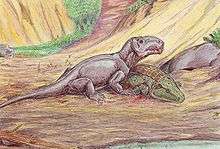1838 in paleontology
Paleontology or palaeontology is the study of prehistoric life forms on Earth through the examination of plant and animal fossils.[1] This includes the study of body fossils, tracks (ichnites), burrows, cast-off parts, fossilised feces (coprolites), palynomorphs and chemical residues. Because humans have encountered fossils for millennia, paleontology has a long history both before and after becoming formalized as a science. This article records significant discoveries and events related to paleontology that occurred or were published in the year 1838.
| |||
|---|---|---|---|
Plesiosaurs
New taxa
| Name | Status | Authors | Notes | |
|---|---|---|---|---|
|
Valid |
Meyer |
|||
|
Valid |
von Meyer |
|||
Synapsids
Non-mammalian
| Name | Status | Authors | Age | Unit | Location | Notes | Images |
|---|---|---|---|---|---|---|---|
|
Kutorga |
A member of Dinocephalia. |
| |||||
|
Nomen dubium |
Kutorga |
Late Permian |
A member of Dinocephalia. | ||||
|
Valid |
Kutorga |
A member of Dinocephalia. | |||||
gollark: It does have a GPU now, though, as I wanted to run GPT-2 slightly faster and was able to obtain a bad one which technically supports CUDA.
gollark: My server is only mildly more powerful than my laptop and has half the RAM, so mostly I just suffer.
gollark: I don't think it's a very good idea, internet connections generally aren't that fast and reliable.
gollark: IIRC they also constrain virtualization somewhat?
gollark: That is *a* thing. You only get 6 simultaneous streams or something.
References
- Gini-Newman, Garfield; Graham, Elizabeth (2001). Echoes from the past: world history to the 16th century. Toronto: McGraw-Hill Ryerson Ltd. ISBN 9780070887398. OCLC 46769716.
This article is issued from Wikipedia. The text is licensed under Creative Commons - Attribution - Sharealike. Additional terms may apply for the media files.
